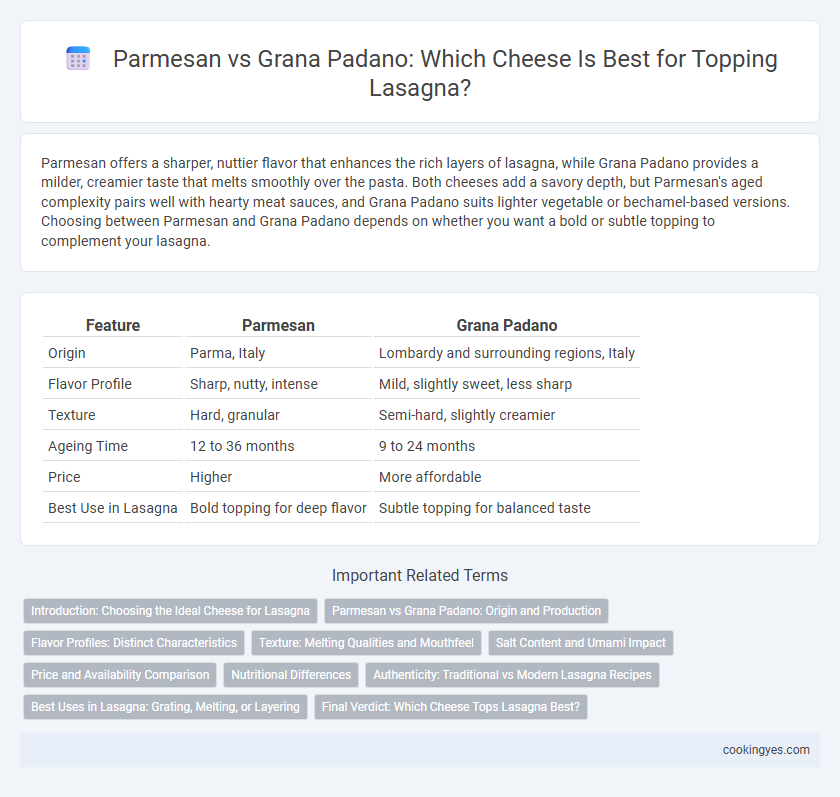Parmesan offers a sharper, nuttier flavor that enhances the rich layers of lasagna, while Grana Padano provides a milder, creamier taste that melts smoothly over the pasta. Both cheeses add a savory depth, but Parmesan's aged complexity pairs well with hearty meat sauces, and Grana Padano suits lighter vegetable or bechamel-based versions. Choosing between Parmesan and Grana Padano depends on whether you want a bold or subtle topping to complement your lasagna.
Table of Comparison
| Feature | Parmesan | Grana Padano |
|---|---|---|
| Origin | Parma, Italy | Lombardy and surrounding regions, Italy |
| Flavor Profile | Sharp, nutty, intense | Mild, slightly sweet, less sharp |
| Texture | Hard, granular | Semi-hard, slightly creamier |
| Ageing Time | 12 to 36 months | 9 to 24 months |
| Price | Higher | More affordable |
| Best Use in Lasagna | Bold topping for deep flavor | Subtle topping for balanced taste |
Introduction: Choosing the Ideal Cheese for Lasagna
Parmesan and Grana Padano are both popular Italian cheeses used to enhance lasagna, each offering distinct flavor profiles and textures. Parmesan delivers a sharp, nutty taste with granular texture, ideal for adding a bold finishing touch, while Grana Padano presents a milder, creamier flavor with a slightly softer texture, perfect for a subtler cheese topping. Selecting between these cheeses depends on the desired intensity and creaminess to perfectly complement the layers of pasta, sauce, and fillings in lasagna.
Parmesan vs Grana Padano: Origin and Production
Parmesan, or Parmigiano-Reggiano, is produced exclusively in designated regions of Italy, including Parma, Reggio Emilia, and Modena, using traditional methods that require at least 12 months of aging. Grana Padano originates from the Po River Valley and has a more flexible production area and aging period, beginning at 9 months, which results in a milder flavor compared to Parmesan's intense, nutty profile. Both cheeses are hard, cow's milk varieties, but Parmesan's strict production regulations contribute to its complex taste, making it a prized topping for authentic lasagna.
Flavor Profiles: Distinct Characteristics
Parmesan offers a sharp, nutty flavor with complex umami notes that enhance lasagna's rich layers. Grana Padano provides a milder, creamier taste with a slightly sweet undertone, delivering a gentler finish. Both cheeses complement lasagna uniquely, with Parmesan intensifying bold flavors while Grana Padano adds subtle, balanced depth.
Texture: Melting Qualities and Mouthfeel
Parmesan cheese features a granular texture that melts smoothly, providing a creamy mouthfeel ideal for lasagna topping. Grana Padano offers a slightly less gritty texture with a more delicate melt, resulting in a silkier finish on lasagna layers. The choice between Parmesan and Grana Padano directly influences the lasagna's overall texture and richness, with Parmesan delivering a more robust melt and Grana Padano offering a subtler, creamier mouthfeel.
Salt Content and Umami Impact
Grana Padano contains less salt than Parmesan, making it a milder option for lasagna toppings while still delivering a rich umami flavor that enhances the dish's depth. Parmesan's higher salt content intensifies savory notes more aggressively, complementing the tomato sauce and cheese layers with a sharper taste. Choosing between the two cheeses depends on the desired balance of saltiness and umami, with Grana Padano offering subtlety and Parmesan providing a bold finish.
Price and Availability Comparison
Parmesan, known as Parmigiano-Reggiano, generally commands a higher price due to its strict production regulations and aging process, making it a premium choice for lasagna toppings. Grana Padano offers a more affordable alternative with similar texture and flavor profiles, benefiting from less stringent aging requirements and wider production regions. Both cheeses are widely available in supermarkets and specialty stores, but Grana Padano's lower cost and easier accessibility make it a popular option for budget-conscious cooks.
Nutritional Differences
Parmesan contains higher protein levels and more calcium compared to Grana Padano, making it beneficial for muscle repair and bone health. Grana Padano has lower fat content and slightly fewer calories, which can aid in weight management while still providing essential nutrients like phosphorus and vitamins A and B12. Both cheeses offer rich umami flavor and essential minerals, but Parmesan is often preferred for its stronger nutritional profile in lasagna toppings.
Authenticity: Traditional vs Modern Lasagna Recipes
Parmesan, known for its sharp, nutty flavor and granular texture, is traditionally favored in authentic Italian lasagna recipes, offering a classic topping that enhances the rich layers of bechamel and ragu. Grana Padano, milder and creamier, is often used in modern variations for a subtler cheese note, appealing to contemporary palates while preserving the lasagna's creamy consistency. Choosing Parmesan solidifies a connection to traditional Emilia-Romagna culinary heritage, whereas Grana Padano introduces a versatile alternative aligned with evolving taste preferences.
Best Uses in Lasagna: Grating, Melting, or Layering
Parmesan cheese, known for its sharp, nutty flavor and granular texture, is ideal for grating over lasagna to add a distinct umami finish and crispy top layer. Grana Padano, milder and creamier than Parmesan, excels in melting within the lasagna layers, contributing a smooth, rich texture without overpowering other ingredients. For layering, Parmesan's robust taste enhances depth, while Grana Padano integrates seamlessly, offering balanced creaminess and subtle sweetness.
Final Verdict: Which Cheese Tops Lasagna Best?
Parmesan offers a sharper, more complex flavor and granular texture that crisps beautifully on lasagna, enhancing its savory depth. Grana Padano provides a milder, creamier taste with a slightly less gritty consistency, lending a subtle richness without overpowering other ingredients. For a classic, bold topping that maximizes flavor contrast, Parmesan is generally the preferred choice, while Grana Padano suits those seeking a gentler, smoother finish.
Parmesan vs Grana Padano for Lasagna Topping Infographic

 cookingyes.com
cookingyes.com